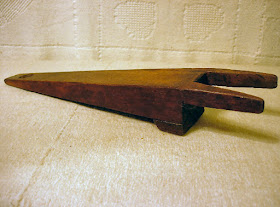When I walk into a house, I am in the habit - as probably many of you also are - of taking my shoes off. It's just a habit that my mother taught me to get into when I was young. Not all habits are good ones, but taking off one's shoes when entering a house is one of those that should be learned as a child, and continued throughout life. It's one of those little courtesies that you can, as a visitor, extend to a host, signifying that you respect his, her or their property.
The process of taking one's shoes off is a very simple one. In most cases, you just place the toe of one shoe against the heel of the other shoe and then pull the second foot out of that shoe. Then you repeat the process by placing the toe of your shoeless foot against the heel of the first shoe, and pull your foot out of that shoe. It should be so simple that any child, with a little practice, can pick it up easily - and hopefully get into the habit.
The only time a person should not take off his or her shoes when entering someone else's (or even your own) house would be if specifically told by the host that it is not necessary. That should be the homeowner's prerogative, though.
So, what is that thing at the top of this post? It's a boot jack.
 The boot jack is a tool, that was very popular in days past, to help in the removal of one's boots. This was in a day and age when loafers and oxfords for men were not even invented yet, and when boots were more common as footwear than were 'regular' shoes.
The boot jack is a tool, that was very popular in days past, to help in the removal of one's boots. This was in a day and age when loafers and oxfords for men were not even invented yet, and when boots were more common as footwear than were 'regular' shoes.Men and boys sometimes wore plain, low shoes, fastened with buckles, and having flat toes making useable on either the left or right foot. But those shoes were worn primarily in dry locations. Roads were not paved, and so when it rained they became muddy pathways. In inclement weather, men wore high leather boots. Also, around the farm, in all the muck and mud, high boots were required footwear.
Men's high boots were difficult to remove easily, so the boot jack was invented to assist that process. The man would place one foot on the long, flat surface of the boot jack. Then he would position the other boot into the "U" or "V" shaped end. That open end of the boot jack was raised, as you can see in some of the photos, so that the wooden jack would touch the boot just above the boot heel, grabbing it and holding it firmly in place as the man pulled his foot out.
 This particular boot jack must not have been high enough to hold the owner's boots securely, so a small piece of wood was tacked onto the bottom.
This particular boot jack must not have been high enough to hold the owner's boots securely, so a small piece of wood was tacked onto the bottom.Boot jacks, such as this one, were commonly made of wood, and did their job adequately well. Into the late 1800s, boot jacks became fabricated out of cast metal. While wooden ones, like this example, are now only found as antiques, but the boot jack is not entirely a thing of the past. They can still be purchased - usually by farmers who still have to work in mud and muck.

No comments:
Post a Comment